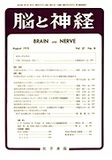Japanese
English
- 有料閲覧
- Abstract 文献概要
- 1ページ目 Look Inside
I.はじめに
実験的脳浮腫あるいはその他の脳障害を作成するには古くから多くの方法がある。しかしそのいずれの方法をとつてみても,厳密な意味で同じ程度の脳損傷を多くの動物に均一に作成することは困難である。
われわれは高周波誘導加熱装置を用いラットの脳に一定量の障害を作成する方法を開発した。この方法は脳に一定量の障害を作成するのに適し,つくられた脳損傷は特に薬剤効果の判定にあたつて有用であると考えられたのでこれについて述べる。さらに,これら脳障害ラットの自発運動の回復程度及び過程を定量的に測定する方法をも考案したのであわせて報告する。
The use of an external radio-frequency electro-magnetic field to produce thermocoagulative lesionsin tissue have been already reported by severalauthors. This technique, which originally wasevaluated of animals and extended to man seemsto show great promise as a neurosurgical tool.Heating is produced by the action of the radio-frequency induction field on surgically implantedmetals having no external connection. The extentof the lesion may be increased to maintain thedesired clinical result by repeated irradiations with-out further operative procedure.
This radiofrequency thermocoagulations byRiechert et al, but this method seems to be poten-tially available for the hypophysectomy as a treat-ment of the diabetic retinopathy and the angiotacticsurgery for some of the cerebral angiomas whichmay be incurable by the conventional surgicaltechnique.
To investigate the pathological processes causedby thes radiofrequency thermocoagulation, experi-ments were performed using 25 rats body weightof which ranged from 200 to 500 gm. An iron ball3mm in diameter was implanted asepticaly incerebral hemisphere of the rats under the generalanesthesia. Two weeks later the implanted ratswhich looked normal were set in the electromagneticgenerater and burdened with various degrees ofelectromagnetic energy. By controlling the energyburdened it was possible to make variously gradedbrain-injured rats i. e. apparantly normal, hemiplegicor seriously disabled. Some of the rats were sacri-fied for the detailed histological examination.Others are followed up in order to observe thelate effects of this telethermocoagulative brain in-jury.
Our tentative conclusion is that the radiofrequen-cy telethermocoagulation method could be a wayto make a experimental brain lesion and might besuperior to the other lesion making methods hithertoreported from the view point of the lesion ratherquantitatively producing.

Copyright © 1975, Igaku-Shoin Ltd. All rights reserved.


